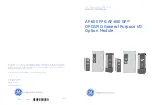
1A-132 Engine Control System
DTC35 - VIM Internal Fault (A/D Conversion Fault)
Circuit Description
The VIM converts analog signals (voltage signals) input
from various sensors into digital signals to perform
diversified control tasks and arithmetic operations.
DTC35 will be set when this A/D (analog-to-digital)
conversion is faulty.
Major Faulty Event
• Generation of white/black smoke
• Inactive idle up volume system
• Inactive PTO accelerator sensor system
Conditions for Setting the DTC
The A/D (analog-to-digital) conversion is not complete
in the VIM.
Action Taken When the DTC Sets
• After the DTC is set, the ECM will illuminate the
CHECK ENGINE lamp (MIL).
• Fault judgment is disabled on PTO accelerator
sensor, atmospheric pressure sensor, and idle up
volume.
Conditions for Clearing MIL/DTC
When the system fails and the DTC is stored to the
ECM, even repairing the faulty portion will not clear the
DTC from the memory. To clear the DTC, conduct the
following steps.
1. Turn off the idle position switch for not less than 1
second but not more than 3 seconds. (Press the
accelerator pedal.)
2. Turn on the idle position switch for not less than 1
second but not more than 3 seconds. (Release the
accelerator pedal.)
3. Turn off the idle position switch for not less than 1
second but not more than 3 seconds. (Press the
accelerator pedal.)
4. Turn on the idle position switch for not less than 1
second but not more than 3 seconds. (Release the
accelerator pedal.)
5. Turn off the idle position switch for not less than 1
second but not more than 3 seconds. (Press the
accelerator pedal.)
6. After the above operations are properly completed,
the CHECK ENGINE lamp (MIL) illuminates for 3
seconds to report the memory is cleared.
7. Turn off the starter switch. Wait for 5 seconds and
turn on the starter switch again.
When Tech 2 has been connected to the vehicle, the
DTC can be cleared through the memory clear
operation with Tech 2.
Diagnostic Aids
Poor connection or damaged harness may cause
intermittents. Check for the following conditions and, if
the fault is detected, repair or replace the faulty portion.
• Poor connection at VIM: Inspect harness
connectors for backed-out pins, improper mating,
broken locks, improperly formed or damaged pins,
and poor pin-to-wire connection.
• Check the past service record for replacement of
VIM.
Test Description
Number(s) below refer to the step number(s) on the
Diagnostic Chart.
3. If the DTC is not detected, the possible cause is
intermittent (intermittent fault).
Step
Action
Value(s)
Yes
No
1
Perform the "On-Board Diagnostic (OBD)
System Check".
Was the OBD System Check performed?
—
Go to Step 2
Refer to OBD
System Check
and go to Step 2
2
Check the VIM connector for installation and,
if mounted improperly, connect it certainly.
Is the action complete?
—
Go to Step 3
—
3
Review the DTC.
1.
Using Tech 2, check and store the DTC.
2.
Clear the DTC.
3.
Perform test run and review the DTC.
Is DTC35 detected?
—
Go to Step 4
Refer to
Diagnostic Aids
















































